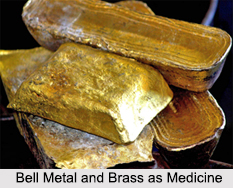 Bell metal, also known as "Kansa", as used in medicine, is an alloy of copper and tin. Brass or "Pitala" is an alloy of copper and zinc. They are sometimes used in combination with other metals, and are regarded as tonic and alterative.
Bell metal, also known as "Kansa", as used in medicine, is an alloy of copper and tin. Brass or "Pitala" is an alloy of copper and zinc. They are sometimes used in combination with other metals, and are regarded as tonic and alterative.
Dose of Bell Metal and Brass in Medicine
Bell Metal and Brass are purified and reduced to powder in the same way as copper. The following is an example of a preparation containing bell metal.
Nityananda Rasa: Take mercury, prepared copper, iron, bell-metal and tin, purified orpiment, sulphate of copper and calcined conch-shell and couries, sulphur, ginger, long pepper and black pepper, the three myrobalans, baberang seeds, the 5 salts namely; rock, sun-dried sea, black, sonchal and Sambar Lake salts, Chavica officinarum (chavika), long pepper root, havusa (an aromatic substance), Acorus Calamus (vacha), Curcuma zedoaria (sati), Stephania hernandifolia (patha), Pinus deodara, cardamoms, seeds of Argyreia speciosa (vridhya daraka) each 2 tolas, rub together with the juice or decoction of chebulic myrobalans and make into 10 grain pills. They are given in hydrocele and elephantiasis of the scrotum. The remark that, when a disease has a long list of drugs for curing it, one may take it for an incurable one, is well exemplified in this medicine for elephantiasis of the scrotum.
This article is a stub. You can enrich by adding more information to it. Send your Write Up to content@indianetzone.com




















